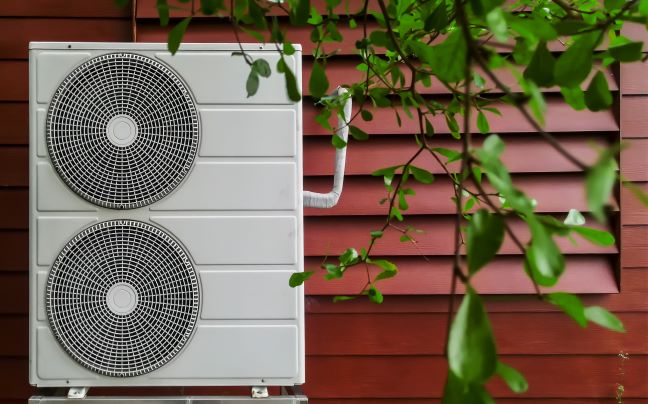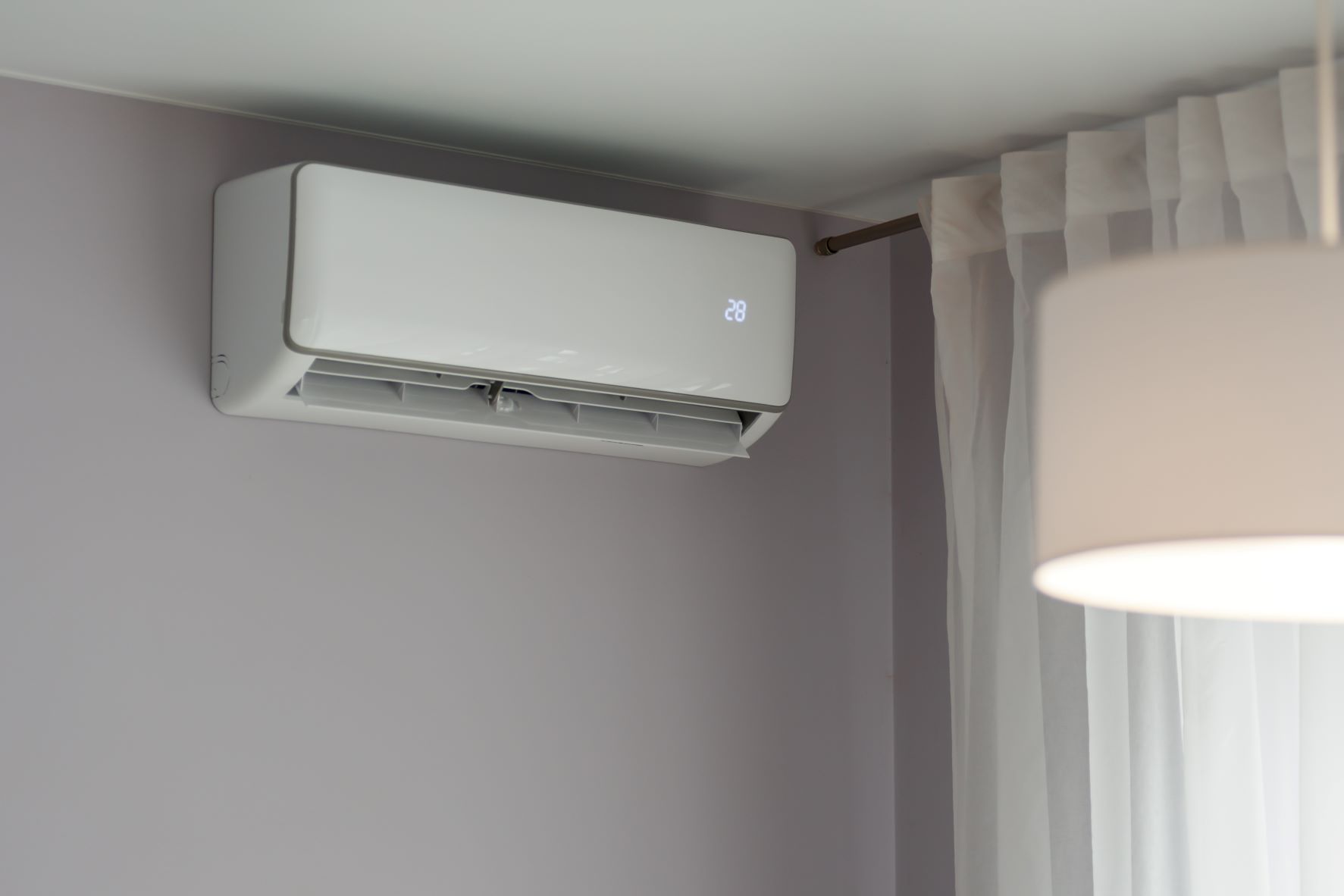
Heating and Cooling with Heat Pumps
Upgrading from a gas furnace to an electric heat pump is one of the most impactful ways to get your house off of fossil fuels. In addition to the environmental benefits, switching to electric improves your indoor air quality and decreases the risk of hazardous gas leaks.
Heat pumps are electric appliances that provide indoor temperature control by moving heat into or out of a building. They do not create heat like electric resistance or fossil fuel-fired heating systems. Instead, they transfer heat from one place to another, allowing them to do the work of both a heater and air conditioner in one. Since it takes far less energy to move heat than it does to create heat, heat pumps are extremely efficient.
Heat pump technology has been around for a long time–in fact, that same technology is what cools your fridge and freezer! Similarly, properly sized and installed heat pumps have no problem keeping your house at your desired temperature, even when it’s freezing outside.
Air Source Heat Pumps (ASHPs)

ASHPs are the most common, and often most economical, heat pumps used for homes. They work by exchanging heat with the air right outside of your home–no digging required.
ASHPs include an outdoor condenser unit mounted on a ground platform or on the side or roof of your building. This outdoor condenser unit will be connected to one or more indoor air distribution units.
ASHPs can be ducted or ductless – meaning that if you don’t have existing central air conditioning or heating, they can be easily installed without extensive construction work.
Ductless systems (also called ductless mini-splits) include one outdoor condenser unit connected to one (single-zone) or more (multi-zone) indoor wall, floor, or ceiling air distribution units. Having multiple zones allows you to address hot and cold areas in your home without having to over-cool or -heat the rest of your home.
Ducted systems (also called central or unitary) have an outdoor condenser unit that is connected to a building’s ductwork and controls the temperature throughout a building. Ducted ASHPs can often work with your home’s existing heating or air conditioning ductwork.

Switching to a heat pump in your home can take some getting used to, because it is a bit different from using a furnace or electric resistance heating. EnergySmart has created user guides to make the transition a little bit easier:
Ground Source Heat Pumps (GSHPs)
Ground source heat pumps (also called geothermal heat pumps) operate similarly to an air source heat pump; however, they use the ground, rather than the outside air, to regulate indoor temperatures.
These heat pumps rely on piping buried in the ground either vertically, horizontally, or through an existing groundwater source. These systems can be installed with ductwork or with hydronic distribution systems in a home.
Many ground source heat pumps can also provide hot water when operating through a desuperheater. Desuperheaters transfer excess heat from the heat pump’s compressor to a hot water tank.
We know that’s a lot of jargon–watch the video to learn more!
Heat Pump FAQ
If you answer “Yes” to any of the questions below, a heat pump system could be a particularly good fit for you:
- Do you want central air conditioning but don’t have (or don’t want to) install ductwork?
- Do you have persistent hot or cold spots in your home?
- Do you want more control over the temperature in individual rooms in your home?
- Are you sensitive to air pollutants and allergens?
- Do you heat with electric resistance heating and want to reduce your energy bills?
- Do you want to reduce your carbon footprint?
- High-efficiency heating and cooling. Heat pumps provide both your heating and cooling capabilities in one unit. Modern high-efficiency heat pumps are as efficient as top-tier central air conditioners and are 2-4 times more efficient than traditional electric heat.
- Enhanced home comfort. Heat pumps give you more control over the comfort levels in your home. Ductless heat pumps can be installed in individual rooms or zones of your home so you can adjust the temperature throughout your home based on your personal needs.
- Health. Burning natural gas (methane) inside our homes can create indoor air pollution. High-efficiency electric heat pumps not only eliminate the risks of these pollutants but also provide air filtration and humidity control to purify the air in your home.
- Flexibility. Heat pumps are a flexible technology that can provide heating and cooling to buildings of all shapes and sizes—regardless of whether you have ductwork or not. Heat pumps are a great option whether you want to replace your entire existing system or just want to add heating or cooling to a one or more room(s).
- Lower your carbon footprint. Heat pumps can be powered by renewable electricity like wind or solar. Even with the current mix of coal, gas, and renewable energy powering our electricity grid, heat pumps are a more environmentally-friendly way to cool and heat your home than gas furnaces.
- Smart. Room-based units can sense and respond to cold or hot spots. Many are also controllable from your phone—in the house or remotely. Warm or cool your house before you even get home!
- Quiet. Heat pumps are often much quieter than traditional heating and cooling systems. Many high-efficiency models will run continuously rather than blasting on and off, reducing disruption to your home.
- Increased resiliency. Efficiently cooling even one room in a home may be a lifesaver for people vulnerable to excessively high temperatures during heat waves due to a warming climate.
Heat pumps both heat and cool your home–so while they are more expensive than a furnace or an air conditioner individually, they are often not much more expensive than replacing both your furnace and air conditioner together.
If your systems are nearing the end of life, switching to a heat pump could save you more in the long run due to lower utility and maintenance costs. Annual system maintenance like cleaning air filters and outside unit checkups costs about the same as annual servicing charges for a central air conditioner or furnace–but for only one appliance. Heat pumps have roughly the same lifetime as furnaces and AC, at roughly 15 years.
In partnership with Boulder County, the City of Boulder, and the City of Louisville, EnergySmart offers rebates for air source heat pumps on a first-come, first-served basis. In addition to EnergySmart rebates, additional incentives may be available from your utility or municipality. Special financing options and tax incentives are also available.
In short, yes! Moving heat is much more efficient than creating heat (like furnaces and electric resistance heaters do), which means heat pumps are at an advantage from the very beginning.
Heat pump efficiency changes from season to season–you may see measurements like Heating Seasonal Performance Factor (HSPF) or seasonal Coefficient of Performance (COP). The seasonal efficiency of heat pumps can range from 220% to 300%+ (i.e. COP of 2.2 to 3.0) depending on the system type and application. That means that for every one unit of electricity used, 2.2 to 3 units of heat are transferred into the home. By comparison, electric resistance heating has a COP of 1.
Heat pumps are even more efficient when used in the shoulder season: if you only use your heat pump when the temperature is above freezing (using your existing furnace for backup for colder days), your system may be 300-400+% efficient!
Using a heat pump to cool your home is comparable to the highest-efficiency air conditioners.
The amount of electricity used by a heat pump will depend on factors like the efficiency of the heat pump, user habits, backup fuel source (if applicable), and other factors in your home like insulation and air tightness. We suggest consulting with a contractor to learn more about a proposed heat pump and its potential usage.
Air source heat pumps are powered by electricity, which is generated through a mix of fossil fuels (like coal and gas) and renewable energy sources (like solar and wind). The emissions associated with our electric grid have been decreasing over time, and policies are in place to ensure that trend continues.
In contrast, gas furnaces will always burn gas. Switching from a gas furnace to a heat pump system will reduce your greenhouse gas emissions from heating by 20-60%–and more if you install solar or opt-in to your utility’s renewable energy programs.
Since air source heat pumps rely on extracting heat from outdoor air, the heating output and efficiency of a heat pump decline as outdoor air temperature decline. High-efficiency heat pumps produce heat down to -13F; however, you may consider keeping a backup heating system for the coldest days of the year.
Common backups include:
- Space heaters or electric baseboards
- Fireplaces (both electric and wood)
- Electric resistance backups
- Keeping your old system in place
It will be extremely rare that you might need backup heat: in the last 20 years, temperatures in Boulder have only dipped below -10F nine times, and only for a few hours at a time.
A new heating pump can help improve comfort issues by allowing you to target things like hot- or cold-spots in your home. However, there may be larger issues to consider, like how well insulated and airtight your home is.
If you are unsure of your home’s efficiency status, we recommend starting with a Home Energy Audit before making any big upgrades.
A heat pump installation is typically a straightforward process with minimal disruption to your home. A simple, single-zone ductless ASHP system can be completed in less than a day and only requires a single 2-3 inch hole to be cut (and later, sealed) in your wall.
If you are installing a “multi-zone” ductless system, a ducted system that requires modifications to your ductwork, or a ground source heat pump, your installation may take a few days or more to complete.
The heatpump size you need will depend on the size and layout of your home, your ductwork (if applicable), your home’s insulation and air tightness, and other factors. We suggest consulting with contractors to complete a load calculation and determine the size needed for your home.
You don’t have to, but you can! Heat pumps can be ducted or ductless.
Ductless air source heat pumps (often called ductless mini-splits) don’t require that you have ductwork in your home to provide heating and cooling. Each ductless system includes one outdoor condenser unit connected to one (single-zone) or more (multi-zone) indoor wall, floor, or ceiling air distribution units. Ductless air-source heat pumps are the most efficient air-source systems and can be installed as a primary source of heating and cooling, or installed to supplement existing systems.
Ducted air source heat pumps (also called central or unitary) have an outdoor condenser unit that is connected to a building’s ductwork and controls the temperature throughout abuilding. Ducted ASHPs can work with your home’s existing heating or air conditioning ductwork, though some modifications may be necessary.
Both ductless and ducted heat pumps will have an outdoor condenser unit mounted on a ground platform, or on the side or roof of your building. This outdoor condenser unit will be connected to one or more indoor air distribution units.
While intuitively you might assume that you should install a ducted heat pump if you already have ductwork, there may be plenty of cases in which a ductless heat pumps might actually be a better option for your needs:
- You have poorly sized ducts or inadequate heating/cooling to particular areas of your home
- You have a new addition on your home, or are planning one soon
- You want to create different temperature zones in your home
- Modifying ductwork in your home is very difficult
Every home (and every homeowner) is different. EnergySmart contractors can help make a recommendation that best suits your specific needs.
Air source heat pumps do not, as they exchange heat with the air rather than the ground. However, ground source heat pumps (also called geothermal heat pumps) do require digging, and are therefore usually a more expensive option.
Typically, no–at least not in the U.S. Some other types of heat pumps (e.g. “air-to-water” heat pumps) can provide both hot water and heating (through radiant floor or hydronic baseboard heating), but these are not very commonly available in the U.S.
Notably, there are water heaters that use heat pump technology (heat pump water heaters, or HPWHs), though they are considered different technologies than ASHPs.
SEER (Seasonal Energy Efficiency Ratio) is a rating scale that measures an air conditioner or heat pump’s energy efficiency. The SEER rating is a system’s cooling output divided by the energy it uses during the warmer part of the year. A higher SEER rating means a more energy-efficient system.
EER (Energy Efficiency Ratio) is another measure of air conditioner or heat pump efficiency. EER measures cooling system performance at 95ºF rather than over an entire cooling season. It measures performance on “peak days”—the hottest days, when your cooling system is working hardest. A higher EER rating means a more energy-efficient system.
HSPF (Heating Seasonal Performance Factor) measures how efficiently a heat pump can heat your home during the cold weather months. It is a ratio of the heat output to electricity use over an average heating season. Specifically, it tells you how much heat energy, measured in British Thermal Units (BTUs), a heat pump will produce for every kilowatt-hour (kWh) of energy consumed to generate heat. For example, a heat pump with an HSPF rating of 8.2 will output 8.2 BTUs for every kWh of input. A higher HSPF rating means a more energy-efficient system.
To see how any of these factors might impact your home’s electric bill and energy usage, we recommend consulting with a contractor who has assessed your home.

Ready to get started?
EnergySmart’s list of contractors can help you find the right team for your project. These contractors are excited to work on electrification projects, and have completed EnergySmart projects in the past.

Not sure where to start?
Get a FREE personalized guide for upgrading your home. By answering just a few questions, you can get personalized recommendations, cost estimates, rebate information, and more.
